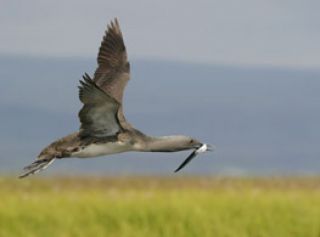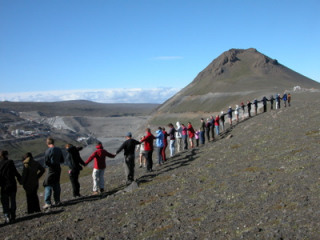From The Icelandic Society for the Protection of Birds
The building of a gigantic hydropower station has started on the northern edge of Europe’s largest glacier, Vatnajökull in Iceland. The power station is needed for the provision of 770 Megawatts for an aluminium smelter being planned by Alcoa in Eastern Iceland, with a capacity of 370,000 metric tons per year. In order for this power capacity to be delivered, one of Iceland’s largest glacial rivers will have to be diverted into another large glacial river, and huge reservoirs will be required in order to maintain the power capacity required throughout the year. The facts and figures of this planned massive intervention in this unspoilt wilderness area are as follows:
• Reservoirs: the largest (Hálslón) will flood 57 square km of land, and a further smaller reservoirs will submerge another 10 square km.
• Dams: the biggest one, in the canyon at Kárahnjúkar, will be 190m high and 770m long; 3 medium-sized dams are collectively 32m high and 1000m long. Additional smaller dams will be built.
•The water will be diverted to the turbines through a 70 km long tunnel/gallery.
• The 150 km long glacial river, Jökulsá á Dal, which has carved out for itself one of the deepest and most attractive canyons in Europe (Dimmugljúfur Canyon, 15 km long – 200 m deep), will be converted to an insignificant stream.
•The diversion of the waters into another glacial river will result in immense changes to the Lagarfljót glacial river (140 km long). Its natural drainage will have to be artificially enlarged and the huge estuary delta will have to be reconstructed.
• Altogether, 3,000 square km or 3% of Icelands total landmass will be affected by this irreversible intervention in the environment. The area affected, where the natural environment and habitats will be destroyed, extends from the edge of the Vatnajökull Glacier to the estuary of the Héraðsflói glacial river.
• A total of 40 square km of land now covered with vegetation will be submerged forever. Soil erosion in the central highlands is one of the greatest environmental problems Iceland has to cope with. It must be feared that the planned reservoirs, where the deposits carried by the glacial rivers will end up (some 10 million metric tons per year), poses an erosion danger when the water level in the reservoirs sink. Yearly water level fluctations of the Hálslón reservoir are 75 m and up to 3/4 of the reservoir will be exposed to wind erosion. This will occur in /winter and spring, when the water reserves will be drawn on. This is the time of year for the wildest storms and even more vegetation will be threatened and covered by the masses of sand and dust carried by violent winds. The effected area of soil erosion will be up to 400 square km.
• A unique former geothermal region with plant fossils will be flooded.
• Flora and fauna: The affected area is one of the few regions in Iceland where the soil and vegetation are still more or less intact. Opponents of the project point out that the project would have unforeseeable consequences for the water table.
• This part of Iceland is home to 1500-2000 reindeer (Rangifer tarrandus) whose summer pastures would be flooded. The total population of reindeer in Iceland is around 4000 animals.
• Some 400-600 female harbour seals (Phoca vitulina vitulina) breed every year on the Jökulsá á Dal delta. By redirecting the river the colony (3-4% of the Icelandic population) would be destroyed.
• The Kárahnjúkar project would affect two IBA’s (BirdLife – Important Bird Areas). Among the bird species whose existence is threatened or would be affected by the changes which the project would bring are:
• Red-throated Diver (Gavia stellata) – 220 pairs
• Pink-footed Goose (Anser brachyrhynchus) – 3800 pairs affected
570 nests would be flooded by the Hálslón reservoir and 2200 pairs would in immediate danger.
9-13.000 moulting geese in the Eyjabakkar IBA will be directly affected by the project.
• Greylag Goose (Anser anser) – 2000 breeding pairs, 10.000 moulting birds affected
• Pintail (Anas acuta) – 100 pairs; 20% of the total Icelandic population
• Shoveler (Anas clypeata) – 5 pairs, one of the rarest Icelandic duck species
• Gyrfalcon (Falco rusticolus) – 27 pairs
• Whimbrel (Numenius phaeopus) – 1000-2000 pairs
• Red-necked Phalarope (Phalaropus lobatus) – over 700 pairs
• Great Skua (Stercorarius skua) – 265 pairs, 5% of the total population
• Arctic Skua (Stercorarius parasiticus) – some 1300 breeding pairs (possibly the world’s largest breeding colony in Úthérað IBA)
Icelandic Society for the Protection of Birds
P.O. Box 5069 • 125 Reykjavík, Iceland • Tel: 562 0477 • Fax: 551 6413
fuglavernd@fuglavernd.is
ISPB (Icelandic Society for the Protection of Birds) in English



